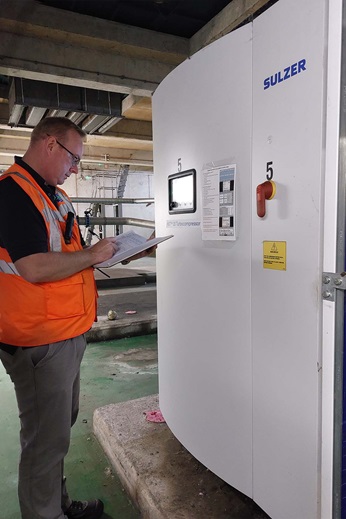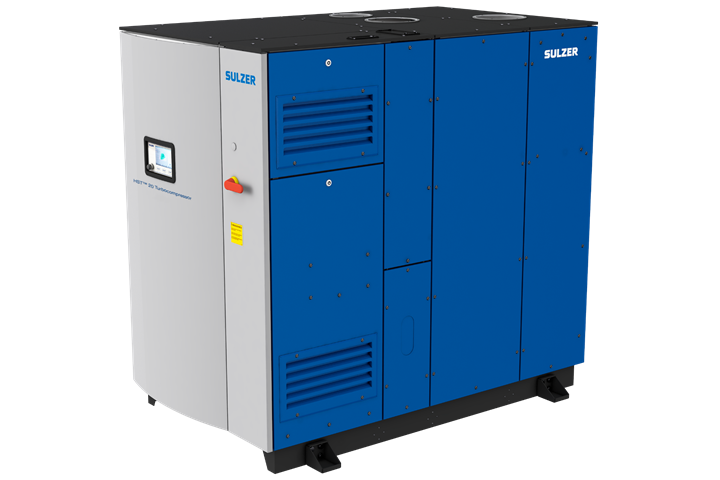-
HST™ turbocompressorThe modern and silent HST™ turbocompressor features an advanced design with proven magnetic bearing technology and a high-speed motor driven through a built-in frequency converter.
Blowing inefficiency away
Sulzer installs six HST 20 turbocompressors for Severn Trent
Airing the water treatment process
Derby Sewage Treatment Works handles wastewater for a population of 440’000, processing an average of 1’000 liters and a maximum 2’300 liters of effluent every second. After water has passed the inlet and mechanical screens, it gravitates into the primary settlement tanks, where solids settle as sludge at the bottom. The sludge is drawn off and anaerobically digested to produce renewable fuel, but liquid flows onto the activated sludge plant (ASP).
Here, ammonia is extracted using biological processes and bacteria. Two key treatments take place. The first is anoxic, where the bacteria are starved of oxygen. The second is aerated, where bacteria utilize air and the contents of the water to fuel the treatment process. This final stage is possible thanks to blowers delivering pressurized air to the ASP.
Solving blower downtime
The blowers at Derby had reached the end of their 20-year service life. Therefore, Severn Trent decided to assess them to see if replacement with more efficient units was feasible. During this process, two blowers catastrophically failed, leaving the site with no spare blower capacity.
Air Technology Ltd conducted a performance comparison of the existing blowers with modern machines from different manufacturers. Sulzer’s HST 20 turbocompressors were preferred, based on the results and six were specified to replace the old units.
The new install was planned just in time, as when work commenced, a third blower failed, which without the replacement project, would have necessitated hiring additional blowers to avoid downtime.
David Wood - Senior Energy Project Manager at Severn Trent
Sulzer air blowers were the best fit for the load and air demand of the site
A challenging project delivered successfully
Work began in November 2020 with the delivery of the HSTs. The old equipment was removed through holes in the basement roof and the Sulzer units lowered into the blower house. New thin wall stainless steel connecting pipework was installed, replacing the aged, heavy steel originals. Aesthetic metal plinths ensure the blowers are all in line and level with each other, simplifying the design of pipework, pipe and cable supports.
The project faced several challenges. First of all, work had to be completed without causing any downtime at the facility and staff still needed access to the blowers to control ongoing ASP processes. This was achieved by commissioning a critical number of blowers to ensure the plant could still run effectively. Concurrently, the old control system was switched over to a fully automated one. The second was due to timing. The project took place during the global pandemic, requiring Sulzer experts to adhere to social distancing, staggered breaks and daily temperature checks.
Benefits beyond efficiency
Full transition to the new blowers was achieved on January 14 2021. The initial period saw the suggested 1.2 GW energy saving per year achieved. This equated to a 34% reduction in blower power consumption. The master control unit (MCU) further optimizes blower operation by calculating the best efficiency. Each offers performance of 7’000 m3/h at 590 mBar, while spinning at 20’000 rpm with no vibrations.
David Wood - Senior Energy Project Manager at Severn Trent
In the water industry, energy savings are a primary consideration and this enabled the funding of this important project. But there are many other benefits. We now have strategic backup blowers and do not just operate on a critical number available. Installing new Sulzer blowers positively impacted the works as the obsoleted blowers would have definitely affected treatment levels. Reduced maintenance is obviously a great advantage - no oil or water maintenance required, only air filters and no wearing parts.
Following the project, a noise assessment was carried out. Severn Trent’s Health and Safety team confirmed that historical noise restrictions could be removed, so operatives working in the blower house basement no longer needed to wear ear protection. “We value very much the reduced noise in Sulzer air compressors and their compact size gives us more open, spacious environment”, David adds.
Public utilities can’t afford to suffer with unreliable or inefficient equipment, or it can impact quality of service. With six new HST 20 turbocompressors running at Derby Sewage Treatment Works, Severn Trent has breathed new life into this aeration process.

